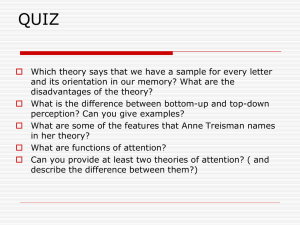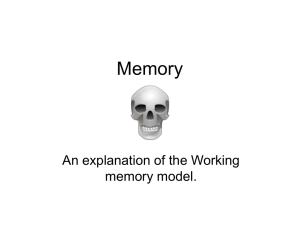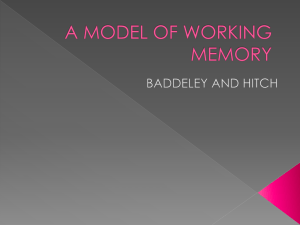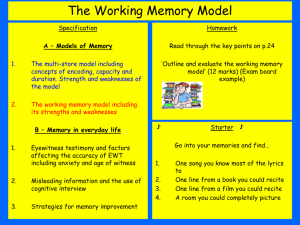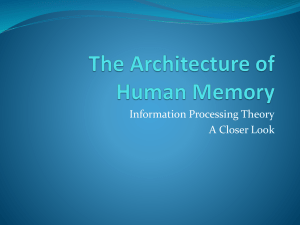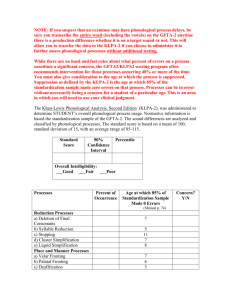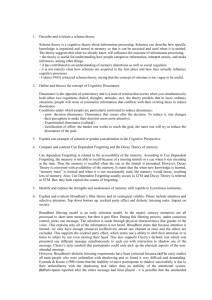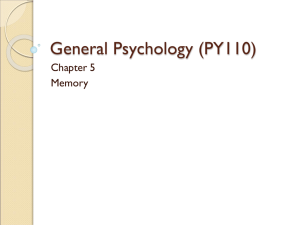working memory
advertisement
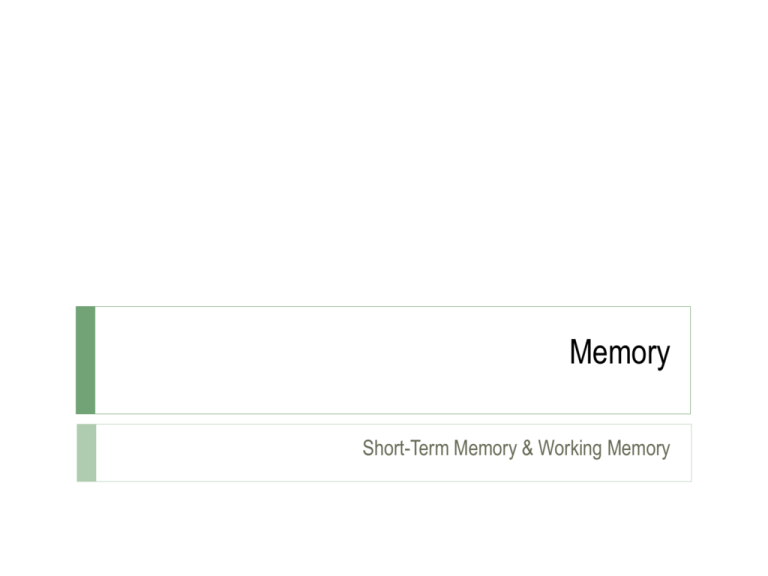
Memory Short-Term Memory & Working Memory THE MULTI-STORE MODEL OF MEMORY Sensory store Holds sensory information for a very brief time Information not attended to is lost Short-term memory (STM) Holds information for limited time 7-9 items capacity Information not rehearsed is displaced Once rehearsed information is transfered to LTM Long-term memory (LTM) Permenant memory store Unlimited ATKINSON & SHIFFIN MODEL SENSORY MEMORY Iconic store Visual information is stored Echoic store Auditory information is stored SHORT-TERM STORE Example: To remember a telephone number Limited capacity and fragile storage Any distraction causes forgetting The recency effect: Last few items in a list are better remembered that the first or middle words. The primacy effect: First few words remembered better than the middle words. SHORT-TERM STORE-Duration Peterson and Peterson (1959) Task of remembering three letters while counting backwards by threes. The ability to remember the three letters declined to 50% after 6 seconds. This indicates that information is lost from short-term memory rapidly. This may be because counting backwards results in interference or diverts attention away from STM. SHORT-TERM STORE: Rehearsal Rehearsal maintains information in short-term memory. Words that are shorter and can be rehearsed rapidly should remain in STM. Words that take longer to reheasre will decay from STM. Some evidence supports this while others do not. Studies which do not support it cast doubt on the fact that short-term memory depends on rehearsal. SHORT-TERM STORE: Forgetting Forgetting from STM: Decay Proactive Interference (disruption of current learning by previous learnt material). Example: Trying to study cognitive psychology after studying for neuropsychology. Neuropsychology inteferes with cognitive psychology learning. WORKING MEMORY Baddeley and Hitch (1974) and Baddeley (1986) Central Executive Resembles attention Controlling unit Phonological Loop Stores speech-based information Visuo-spatial sketchpad Limited capacity Stores visual-based information Episodic buffer Integrates information from the Visuo-spatial sketchpad and Phonological loop. Controlled by the Central Executive WORKING MEMORY WORKING MEMORY WORKING MEMORY Assumptions If two tasks use the same componet, they cannot be performed successfully together. If two tasks use different components, it should be possible to perform them well together. WORKING MEMORY PHONOLOGICAL LOOP Phonological Similarity Effect Recall of words is better when words sound different than when they sound the same. Example: Recall is better for words such as UP and ODD, than HE and KNEE Speech based reherasal within the phonological loop WORKING MEMORY PHONOLOGICAL LOOP Word Length Effect Better recall of shorter words than longer words. Takes longer time to rehearse the longer words which causes greater levels of decay. WORKING MEMORY PHONOLOGICAL LOOP A passive phonological store directly concerned with speech production An articulatory process linked to speech production that gives access to the phonological loop Auditory presentation of words gain direct access to the phonological store Words presented visually need to be articulated then gain access to the phonological store – access is therefore indirect Word length effect therefore is dependent on articulatory rehearsal PHONOLOGICAL LOOP VISUO-SPATIAL SKETCHPAD Temporary storage and manipulation of spatial and visual information. Two components: The visual cache Stores information about visual form and colour. The inner scribe Deals wıth spatial and movement information. Rehearses information in the visual cache. Tranfers information from the visual cache to the central executive. Involved in the planning and execution of body and limb movements. CENTRAL EXECUTIVE Most important component of working memory. Damage to the frontal lobes can cause impairements to the central executive. Functions: Switching attention between tasks. Planning subgoals to achieve goals. Selective attention and inhibition. Updating and checking the contents of working memory. Coding representations in working memory for time and place of appearance. CENTRAL EXECUTIVE Single or multiple central executive functions? Evidence favours the latter (i.e., multiple) Three central executive functions: Shifting attention Updating information Response inhibition All share common processes (e.g., attention) but also function independently. EPISODIC BUFFER Stores and intergrates information from both the phonological loop and visuo-spatial sketchpad. MEMORY PROCESSES Encoding Storage Retrieval TESTS OF MEMORY Free recall Hardest type of recall Least environmental support Cued recall Second hardest type of recall Provides some environmental support Recognition Easiest type of recall Memory best under recognition Provides environmental support TEST OF MEMORY Explicit Memory Conscious and deliberate retrieval of past events Exam Implicit Memory Memory not involving consious recollection Word stem completion Complete the word ‘Ten___’ LEVELS OF PROCESSING Craik and Lockhart (1972) Attentional processes at learning determine what information is stored in long-term memory. Various levels of processing Shallow processing: Physical analysis of stimuli. Deep or semantic processing: Analysis of meaning. Deep or semantic processing produce more elaboration, longer lasting and stronger memory traces than shallow processing. LEVELS OF PROCESSING Craik and Lockhart (1972) Two types of rehearsal: Maintenance rehearsal Repeating information to remember it. Elaborative rehearsal Involves semantic-meaning processing. Information which is sematically processed will be trasnfered to long term memory. ELABORATION Craik and Tulving (1975) Elaboration of processing is important Aids LTM The kind and amount of elaboration is critical for recall Precise semantic encodings are better DISTINCTIVENESS Eysenck (1979) Distinctive or unique memory traces are recalled more than non distinctive memory traces. THEORIES OF FORGETTING Ebbinghause studied forgetting with himself being the only participant. He learned and recalled a list of nonsense syllables which had no meaning over several trials. Forgetting was very rapaid over the first hour after learning which slowed down thereafter. REPRESSION Freud argued that anxiety provoking material is often unable to gain access to conscious awareness, known as repression. Adaptive function to maintain psychological well-being. INTERFERENCE THEORY Dominant approach Ability to remember currently learned information can be disrupted with previously learnt material or what we learn in the future. Proactive Interference Previous learning interferes. Retroactive Interference Later learning disrupts earlier learning. CUE-DEPENDENT FORGETTING Tulving (1974) Trace-Dependent Forgetting Information is no longer stored in memory Cue-Dependent Forgetting Information is stored in memory but cannot be accessed Cue-dependent forgetting associated with external cues (categories) and internal cues (mood) If the mood of retrieval is different from learning information will be blocked The mood effect is stronger for positive than negative moods and for personal events CONSOLIDATION Is a process lasting for several hours or even days which fixes information in LTM. ‘New memories are clear but fragile and old ones are faded but robust’ (Wixted, 2004, p.265). Consolidation process for one memory can be distrupted by other memories, so better consolidation will take place during sleep than awake as fewer memories are being formed. CONSOLIDATION Sleep will aid the consolidation period early in the retention interval, as, thats when memories are vulnerable to disruption. Those who slept after learning remembered 81% than those who slept later 66%.
